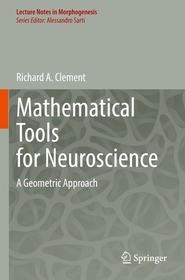
Mathematical Tools for Neuroscience
A Geometric Approach
Sorozatcím: Lecture Notes in Morphogenesis;
-
20% KEDVEZMÉNY?
- A kedvezmény csak az 'Értesítés a kedvenc témákról' hírlevelünk címzettjeinek rendeléseire érvényes.
- Kiadói listaár EUR 128.39
-
53 249 Ft (50 714 Ft + 5% áfa)
Az ár azért becsült, mert a rendelés pillanatában nem lehet pontosan tudni, hogy a beérkezéskor milyen lesz a forint árfolyama az adott termék eredeti devizájához képest. Ha a forint romlana, kissé többet, ha javulna, kissé kevesebbet kell majd fizetnie.
- Kedvezmény(ek) 20% (cc. 10 650 Ft off)
- Kedvezményes ár 42 600 Ft (40 571 Ft + 5% áfa)
Iratkozzon fel most és részesüljön kedvezőbb árainkból!
Feliratkozom
53 249 Ft

Beszerezhetőség
Megrendelésre a kiadó utánnyomja a könyvet. Rendelhető, de a szokásosnál kicsit lassabban érkezik meg.
Why don't you give exact delivery time?
A beszerzés időigényét az eddigi tapasztalatokra alapozva adjuk meg. Azért becsült, mert a terméket külföldről hozzuk be, így a kiadó kiszolgálásának pillanatnyi gyorsaságától is függ. A megadottnál gyorsabb és lassabb szállítás is elképzelhető, de mindent megteszünk, hogy Ön a lehető leghamarabb jusson hozzá a termékhez.
A termék adatai:
- Kiadás sorszáma 1st ed. 2022
- Kiadó Springer International Publishing
- Megjelenés dátuma 2023. április 22.
- Kötetek száma 1 pieces, Book
- ISBN 9783030984977
- Kötéstípus Puhakötés
- Lásd még 9783030984946
- Terjedelem162 oldal
- Méret 235x155 mm
- Súly 273 g
- Nyelv angol
- Illusztrációk X, 162 p. 121 illus., 106 illus. in color. Illustrations, black & white 456
Kategóriák
Hosszú leírás:
Tartalomjegyzék:
- 1. Mind and Brain. - 2. Biological Objects. - 3. Measurements. - 4. From Local to Global. - 5. Actions. - 6. Brain and Body. - 7. Analysis of Experimental Measurements. - 8. Where Are We Going With All This?. - 9. Appendix: Background Material.
Több



